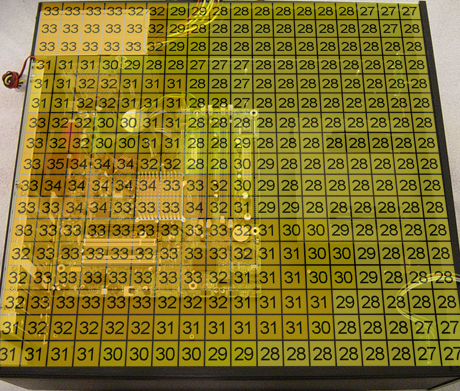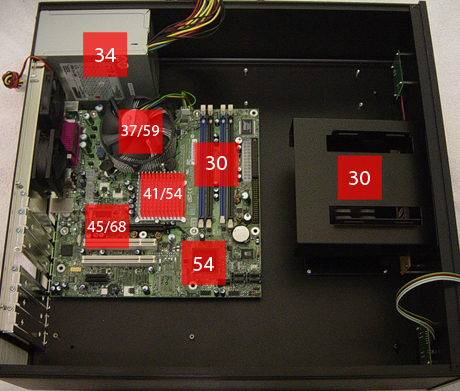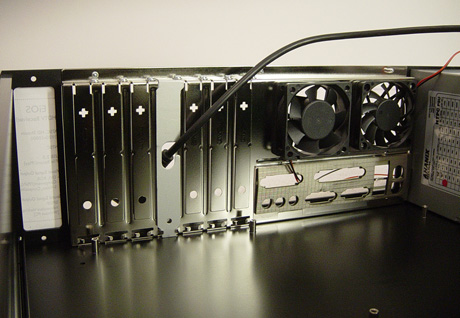Intel's Long Awaited BTX Form Factor
by Purav Sanghani on November 15, 2004 5:31 AM EST- Posted in
- Cases/Cooling/PSUs
Thermals Desktop ATX
We tested our D915GUX board and Pentium 550 CPU in Ahanix's D.Vine 5 HTPC chassis, the successor to the D.Vine 4 we reviewed last month, since it had the size of a typical mid tower case yet took on the form of a flat lying desktop case like the B300 to give a better idea of how this hardware performed in a case with sizes we are used to. Unlike Opus Technologies, Ahanix has a great deal of products, many of them cases which is their main focus. The first case we reviewed from Ahanix was their Black Knight. The Black Knight performed well in our thermal benchmarks while averaging at 50dBA in sound We again measure temperatures of the ambient air inch by inch to show how each component affects various areas of the case.
Click to Enlarge
It is evident that the warmest region in our desktop ATX system is between the CPU, Northbridge, and PCIe VGA card followed by the power supply. We also notice how the rear exhaust fans are pulling the warm air towards them to the outside. The D.Vine 5 has an extremely large footprint, 17" in width by 18" in depth, so there are many areas which are not being exposed to warm air such as the front corners as well as the left side of the case.

Click to Enlarge
We see here that the CPU, Northbridge heatsink and the PCIe VGA card are the hottest components in the system. The Southbridge also ran extremely hot at 54 degrees, but it is too small to have as great of an effect on the ambient air around it as did the other three. The power supply, on the other hand, measured to be 34 degrees which had a great affect on its surrounding air.

Click to Enlarge
Again, since the D.Vine 5 lies flat instead of upright like the TT-501 does, heat pockets mainly occur over the equipment giving off the heat instead of at the top of the case (the right side in this case) near the power supply.










77 Comments
View All Comments
DerekBaker - Monday, November 15, 2004 - link
#25From here I should think: ">From the picture we see the flow of warm air pulled forward from beyond the VGA card. As it moves towards the front of the case the air flows over the Southbridge and Northbridge passively cooling each chip. We then see from the shades of red the air warms up as it flows through the CPU heatsink then begins to cool as it moves out the front of the case."
http://www.anandtech.com/casecooling/showdoc.aspx?...
Derek
Oxonium - Monday, November 15, 2004 - link
Let's see, a new form factor with new case requirements and STILL no standardized connector for the front Power/Reset/LED's/etc.? I'm all for cooler cases, but a standardized connector for those items is something that should have been implemented years ago.HardwareD00d - Monday, November 15, 2004 - link
#24, who cares since athlons run much cooler and don't need this case form factor.Doormat - Monday, November 15, 2004 - link
I heard a rumor that it wont work with Athlon 64 chips or any type of chip that has the memory controller integrated with the processor, because the distance between the processor and the RAM banks are too far. Anyone confirm this?Superbike - Monday, November 15, 2004 - link
Wow AT is back.phisrow - Monday, November 15, 2004 - link
While I agree that the tweaky enthusiast market doesn't have much to gain at the moment by moving from ATX to BTX, especially as most of them are running A64s or praying-for-death overclocked mobile Athlons, I think there is certainly something to be said for the form-factor. It does seem to be more efficient for cooling than your average ATX(especially for small cases). Even if you are running some PentiumM or a derivative thereof, more efficient is still better. After all, if a given case design can cool a high-end Prescott without deafening its user, it can probably cool a brutally overclocked Pentium M with its fans running at half the speed. For that matter, if the trace length issues aren't actually crippling, I would like to see some A64 motherboards in this format.johnsonx - Monday, November 15, 2004 - link
Visualize an office full of MicroBTX Desktop computers. Visualize the women in the office cupping their hands around the heat exhaust... visualize the overclocking tips flowing around the female staff as they strive to increase heat output... visualize the men pouring sweat, desparately trying to duct-tape the front vent to block the hot Intel Air.I'm sorry, but any spec that seeks to exhaust hot air out the FRONT of any case, whether it be a desktop, tower or SFF, is just plain STUPID.
araczynski - Monday, November 15, 2004 - link
my god, after all these years, they fall back on the packard bell mentality...KristopherKubicki - Monday, November 15, 2004 - link
GTMan: Temperatures were certainly taken with the cases closed.Kristopher
GTMan - Monday, November 15, 2004 - link
I wonder if all those temperature measurements were done with the case open? I would think a case designed for efficient air flow would only perform properly (as designed) when fully assembled!!!